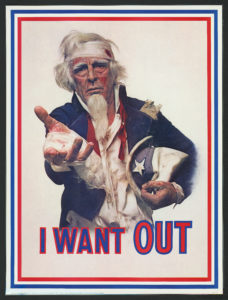Know
‘Signs of Resistance’ author Siegler to speak at Museum of Fine Arts

Award-winning graphic designer Bonnie Siegler visits St. Petersburg’s Museum of Fine Arts Thursday, March 29, for a one-on-one conversation with Executive Director Kristen Shepherd.
The New York-based Siegler will be talking about her just-published book Signs of Resistance: A Visual History of Protest in America, which collects over 200 years of iconic imagery, from Revolutionary War-era political cartoons, through suffrage, immigration, World War II, the Civil Rights struggle, Viet Nam and into the modern age.
Many of the images she’s curated for the book will be familiar; others not so much.
One of the last chapters is titled Trump: Make America Resist Again. It’s page after page of anti-Trump posters, cartoons, memes and more.
Siegler, whose Eight and One-Half Design has worked with Newsweek, Saturday Night Live, Participant Media and HBO, among many others, was called to this particular action after our 45th president was elected. A relative newbie to political protest, she was researching eye-catching images that might help her express her disapproval.
“I felt only rage and anger for a while, but looking through these images and through these past movements actually gave me some feeling of hope that there were other times when people were filled with rage and anger,” she explains.
“They took to the streets, or tried to do whatever they could do to change it – and time moved on and everything was OK again. We get through it with some rage, and some hope that there will come the day.”
The MFA event is free with regular museum admission. Learn more here.
Why does this sort of message work best simple, stark, direct?
It’s true – even since 1774, the Benjamin Franklin one, “Join or Die.” This little drawing he did 250 years ago, people still know it today. They might not know exactly what it was for, but they understand the sentiment immediately because it was so clear, and so simple, that it was easy to be memorable. If he made a complex thing with a map, and pointed to the different areas he was talking about, who was resisting and who wasn’t, nobody would remember it at all.

What surprised you more than anything else on this journey?
The thing I learned the most about was probably the civil rights movement. Like that symbol for the abolitionists, “Am I Not a Man and a Brother.” That lasted for over a hundred years, as a symbol for emancipation, and I had never seen it before. And how it was a precursor to the famous “I Am a Man” posters. The backstory to a lot of these things that I had no idea about – Rosie the Riveter is another really good example. I thought what everybody else thought about that poster!
Or the woman flexing her arm saying “We Can Do It!” I’ve seen so many variations on that one.
Right, but they all play off the power of the original image. They’re all using it, so it’s a shorthand to get their message across. You know that by using the Uncle Sam image, for example, that has to do with the military. So you don’t need to put other stuff in it. You use that as shorthand for the bigger picture, and then you can make your play on it very quickly and easily and simply.
As a designer, did you get what they were going for right away? Were you genuinely moved by how effective some of these things were to your eye, to your brain, to your heart?
Oh, definitely. In curating it, I definitely appreciated all the images that are in the book. There’s a giant pile of posters that didn’t make it into the book, that I would have said that about. But I did choose things that I pretty much fell in love with and was moved by.

This was a history lesson hiding in plain sight. I can imagine you felt pretty good that you’d put it all in one place, for history?
I also think it’s really good for younger people, obviously the teens today are getting involved and are more powerful than the adults. Parkland, of course, but also around the country … I mean, I’ve seen it at the women’s marches, all the young women especially who are feeling the power and understanding their place in society. And that they have so much more power than we felt we did when we were 17 years old.
It’s a kind of Instagram version of history. It’s a way to learn about history in an engaging, colorful way … it’s all really trying so hard to get its message across. It’s all so full of passion, which is what these kids are.







